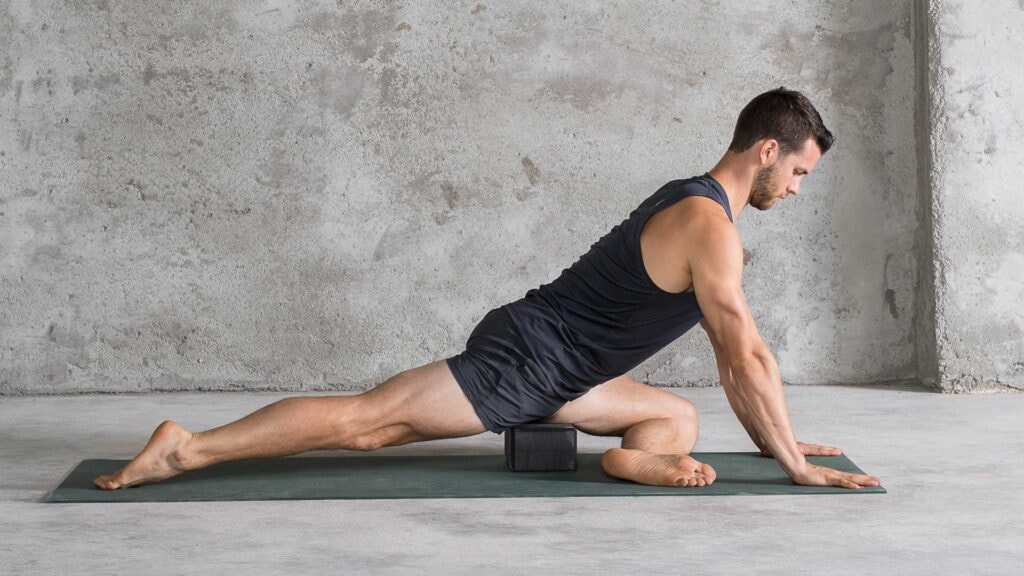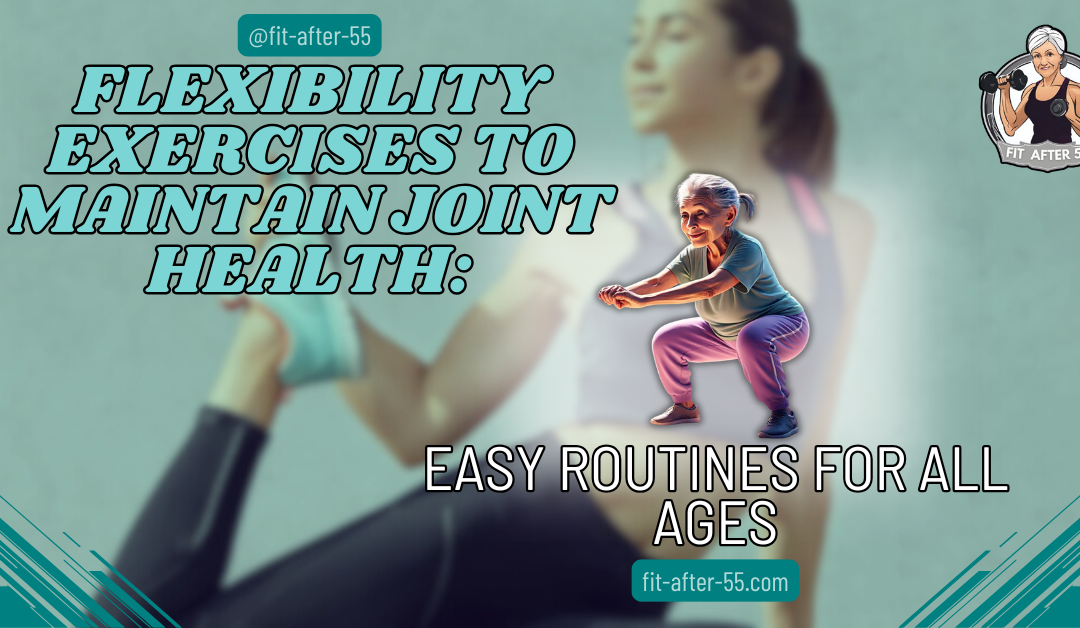Flexibility exercises are essential for maintaining joint health, especially for older adults who want to stay active and independent as they age. These exercises help preserve the body’s natural range of motion, reduce stiffness, and minimize the risk of joint-related issues. By focusing on gentle, targeted movements, seniors can improve their mobility, making daily tasks and cherished activities easier and more enjoyable. A few minutes of flexibility work daily can make a big difference in supporting healthy joints and enhancing overall well-being.
In this article, we’ll explore flexibility exercises specifically designed to meet the needs of older adults, promoting joint health and alleviating discomfort. From simple stretches to adaptive movements, these routines are perfect for all fitness levels and can be done at home or with minimal equipment. With clear guidance and helpful tips, seniors can discover how to safely integrate these exercises into their lives for long-lasting benefits. Ready to embrace a more flexible, pain-free lifestyle? Let’s get started!
Essential Flexibility Routines for Healthy Joints and Better Mobility

Keeping your joints healthy is key to staying active and pain-free. Flexibility exercises can help you maintain good joint health and lower your risk of injuries. Regular stretching and mobility work can improve your range of motion, prevent stiffness, and keep your joints happy.
By adding flexibility training to your workout routine, you can enjoy better posture, less muscle tension, and smoother movement in your daily life. It’s not just for athletes – everyone can benefit from these simple yet effective exercises. Whether you’re a beginner or more advanced, plenty of options suit your needs and fitness level.
Key Takeaways
- Regular flexibility exercises can improve joint health and reduce injury risk.
- Stretching routines can be tailored to fit all fitness levels and goals.
- Combining flexibility work with strength training and proper nutrition supports overall joint health.
Understanding Joint Health
Joints play a crucial role in your body’s movement and flexibility. Keeping them healthy allows you to stay active and pain-free as you age. Let’s explore how flexibility impacts joint function and the benefits of maintaining good joint health.
The Role of Flexibility in Joint Health
Flexibility helps your joints move smoothly and comfortably. When you’re flexible, your joints can go through their full range of motion without strain. This reduces wear and tear on the joint surfaces. Some key points about flexibility and joints:
- Stretching keeps the muscles around your joints loose and limber.
- Regular stretching improves blood flow to your joints.
- Good flexibility can help correct muscle imbalances that stress joints.
Aim to do flexibility exercises 2-3 times a week. Focus on major joints like hips, shoulders, and knees. Hold each stretch for 15-30 seconds without bouncing.
Benefits of Maintaining Good Joint Health
Taking care of your joints pays off in many ways. Healthy joints let you stay active and independent as you get older. Here are some top benefits of joint health:
- Less pain and stiffness in daily activities.
- Improved posture and balance.
- Lower risk of falls and injuries.
- Better sports performance and fitness results.
Good joint health also helps with rehabilitation after injuries. Your doctor may recommend specific exercises to rebuild joint strength and mobility.
A Curious Fact:
Eating the right foods and staying hydrated is key to keeping your joints healthy and flexible. These habits can reduce inflammation and support your body’s natural repair processes.
Flexibility Exercises for Beginners

Stretching and gentle yoga are great ways for older adults to improve their flexibility. These exercises can help loosen tight muscles, increase the range of motion, and promote better joint health. They’re easy to do at home, require no special equipment, and can be adapted to suit different fitness levels and mobility needs.
Basic Stretching Techniques
Start with simple stretches to warm up your muscles. Hold each stretch for 15-30 seconds without bouncing. Try these easy moves:
- Neck Rolls: Gently rotate your head in circles.
- Shoulder Shrugs: Lift your shoulders to your ears, then relax.
- Hamstring Stretch: Sit on the floor with your legs straight and reach for your toes.
- Calf stretch: Step one foot forward, bend your front knee, and keep your back leg straight.
Remember to breathe deeply while stretching. This helps you relax and get more out of each move. Don’t push too hard – you should feel a gentle pull, not pain.
Gentle Yoga Poses for Flexibility
Yoga is great for improving flexibility and joint health. Here are some beginner-friendly poses:
- Child’s Pose: Kneel on the floor, sit back on your heels, and stretch your arms forward.
- Cat-cow Stretch: On hands and knees, arch and round your back.
- Downward-facing Dog: Form an inverted V-shape with your body.
- Standing Forward Bend: Bend your hips and let your arms hang down.
Start with 5-10 minutes of yoga daily. Focus on your breath and move slowly. If a pose feels uncomfortable, ease off or try a different one. With regular practice, you’ll notice improvements in your flexibility and overall well-being.
Watch this video on a quick morning stretching routine to improve flexibility, mobility, and relieve stiffness.
By: Tone and Tighten
Flexibility Training for Intermediate Levels
Flexibility training at the intermediate level combines dynamic movements and strengthening exercises. You’ll focus on improving your range of motion and building stability in your joints.
Dynamic Stretching for Improved Mobility
Dynamic stretching helps you warm up your muscles and joints before exercise. Start with arm circles and leg swings to get your blood flowing. Try walking lunges with a twist to stretch your hips and back. Add high knees and butt kicks to warm up your legs. These moves prepare you for more intense activities.
Do 10-15 reps of each exercise. Move slowly at first, then speed up as you feel warmer. This helps prevent injury and boosts your performance. Remember to breathe deeply as you stretch. It helps you relax and increases oxygen flow to your muscles.
Pilates for Strengthening and Flexibility
Pilates is great for joint health and flexibility. It builds core strength and improves posture. Start with the hundred exercises to warm up your core. Then, try the roll-up to stretch your spine and strengthen your abs. The saw exercise is perfect for side-body stretching.
Add leg circles to work your hips and thighs. The single-leg stretch helps with balance and core control. Do each exercise for 30-60 seconds. Focus on your form and breathing. Quality matters more than quantity in Pilates. Mix Pilates with your strength training routine. It helps prevent muscle imbalances and keeps your joints flexible.
Advanced Stretching Routines

Advanced stretches can help older adults improve flexibility and joint health. These routines target specific muscle groups and joints, enhancing overall mobility and supporting an active, independent lifestyle.
Isometric Stretches for Joint Stability
Isometric stretches are great for building joint stability. You hold a position without moving, which helps strengthen the muscles around your joints. Try the wall sit for your knees and hips. Stand with your back against a wall and slide down until your thighs parallel the ground. Hold for 30 seconds.
For shoulder stability, do a doorway chest stretch. Stand in a doorway with your arms on the frame at shoulder height. Lean forward until you feel a stretch in your chest. Hold for 20-30 seconds. Remember to breathe deeply during these holds. Start with 2-3 sets of each exercise and gradually increase as you get stronger.
Advanced Yoga Sequences for Flexibility
Yoga can greatly improve your flexibility and joint health. Try these advanced poses to challenge yourself:
- Pigeon Pose: Great for hip flexibility.
- Wheel Pose: Opens up your chest and stretches your spine.
- Standing Split: Improves hamstring flexibility and balance.
Start with 5-10 breaths in each pose. Always warm up before attempting these advanced poses. Combine yoga with strength training to maintain muscle balance. This helps protect your joints while increasing flexibility. Remember to listen to your body. If a stretch feels painful, back off and try an easier version. Consistency is key to improving your flexibility and joint health.
Believe It or Not:
Keeping tabs on your flexibility journey helps you stay motivated and see real improvements. Setting clear goals gives you something to work towards while maintaining healthy joints.
Developing a Personalized Flexibility Routine
Creating a tailored flexibility plan helps older adults improve joint health and overall fitness. By focusing on their specific needs and incorporating flexibility exercises into their workouts, they can achieve better results and maintain an active lifestyle.
Assessing Your Flexibility Needs
Start by checking your current flexibility. Try simple tests like touching your toes or reaching behind your back. Notice any tight spots or areas where you can’t move easily. Think about your daily activities and any sports you play. Do you sit at a desk all day? Play tennis on weekends? This info helps you know which joints need extra attention.
Talk to a doctor or physical therapist if you’re recovering from an injury. They can guide you on safe stretches for rehabilitation. Remember, everyone’s flexibility needs are different. What works for your friend might not be right for you.
Incorporating Flexibility Training Into Your Exercise Regimen
Add stretching to your workout routine. Warm up with light cardio, then do dynamic stretches. Save static stretches for after your workout when your muscles are warm. Try to stretch 2-3 times a week for 10-15 minutes. Flexibility exercises can help maintain joint health and prevent injuries.
Mix it up! Use yoga, Pilates, or tai chi to improve flexibility. These activities also boost balance and strength. Pair stretching with strength training. Strong muscles support flexible joints. Aim for a balanced routine that includes both. Listen to your body. If a stretch hurts, stop. Gentle tension is okay, but pain means you’re pushing too hard.
Injury Prevention and Joint Care

Protecting your joints is key to keeping older adults active and independent. A smart approach to flexibility exercises can help prevent injuries and maintain joint health for years.
Warm-Up and Cool-Down Strategies
Start your workout with a proper warm-up. This gets your blood flowing and prepares your muscles for exercise. Try light cardio, like jogging in place or jumping jacks for 5-10 minutes. Next, do some dynamic stretches to loosen up. Arm circles, leg swings, and torso twists are great options. These moves help boost your range of motion safely.
After your workout, cool down with static stretches. Hold each stretch for 15-30 seconds. This helps your muscles relax and can reduce soreness later. Remember to breathe deeply during your cool-down. It helps your body transition back to its resting state.
Understanding and Avoiding Overstretching
While flexibility is good, pushing too far can hurt you. Listen to your body and stop if you feel pain. A gentle pull is okay, but sharp pain means you’ve gone too far. Don’t bounce when you stretch. This can cause tiny tears in your muscles. Instead, ease into each stretch slowly and hold it steady.
Consistency is better than intensity. Regular, moderate stretching is safer and more effective than occasional extreme sessions. If you’re recovering from an injury, be extra careful. Talk to your doctor or a physical therapist about safe exercises.
Flexibility Exercises: Addressing Common Challenges

Staying flexible can be tricky. You might face some hurdles on your journey to better joint health. Let’s look at ways to deal with these issues.
Dealing with Plateaus in Flexibility Training
Plateaus happen when you stop seeing progress. Don’t worry – this is normal! Try mixing up your routine. Add new stretches or change the order of your exercises. You can also hold your stretches for longer. Start with 15 seconds and slowly work up to 60 seconds.
Remember to breathe deeply while you stretch. Another tip is to stretch more often. Instead of once a day, try quick stretching breaks throughout your day. This can help you push past that plateau.
Modifying Exercises for Specific Joint Issues
If you have joint problems, you can still do flexibility exercises. You just need to make some changes. For knee issues, try seated stretches instead of standing ones. This takes the pressure off your knees.
For shoulder problems, use a towel or strap to help with overhead stretches. This lets you stretch without pushing too hard. If your wrists hurt, do hand stretches with your palms on a table.
Always listen to your body. Stop if something hurts. Gentle stretching can help with joint pain, but pushing too hard can worsen things.
Check out this video on improving your flexibility with 7 effective stretching exercises for seniors and beginners.
By: yes2next
Embracing Flexibility for Healthy, Active Joints
Flexibility exercises are vital in maintaining joint health and ensuring mobility as we age. Incorporating stretching, yoga, and Pilates into a routine can help reduce stiffness, improve range of motion, and lower the risk of joint-related injuries. These exercises also support posture, balance, and overall well-being, enabling elderly individuals to stay active and independent. By focusing on gentle yet effective movements tailored to their needs, seniors can enjoy the benefits of healthier joints and a more comfortable lifestyle.
Consistency and proper technique are key to achieving results. Whether starting with basic stretches or advancing to dynamic and isometric exercises, a well-rounded approach can enhance flexibility and joint stability. Pairing flexibility training with strength exercises and good nutrition creates a holistic plan for joint care. By dedicating time to joint health, seniors can continue engaging in their favorite activities while reducing the risk of pain and injury. Prioritize flexibility for a more vibrant, active life at any age!
Frequently Asked Questions
Flexibility exercises are key for keeping your joints healthy. Here are some common questions about how to do them right and get the most benefit.
What Are Some Good Warm-up Exercises to Improve Flexibility for Joint Health?
Try gentle arm circles and leg swings. Slow walking or marching in place also works well. These moves get blood flowing to your joints. They prepare your body for deeper stretches.
How Often Should I Perform Flexibility Training to Benefit My Joints?
Aim to stretch 2-3 times per week at minimum. Daily is even better if you can manage it. Even 5-10 minutes daily can make a big difference for your joint health.
Can You Suggest Any Specific Stretches That Target Multiple Joints?
The butterfly stretch is great for hips and lower back. The child’s pose targets shoulders, spine, and hips. Lunges work on hips, knees, and ankles all at once.
Reignite Your Fitness Journey After 55!
Welcome, fitness enthusiasts! Discover the keys to a vibrant, active lifestyle with Fit After 55. Whether you’re a beginner or experienced, we provide practical tips on setting goals and monitoring progress. Join our community and kick-start your fitness transformation today by visiting our website and connecting with us on Facebook!

